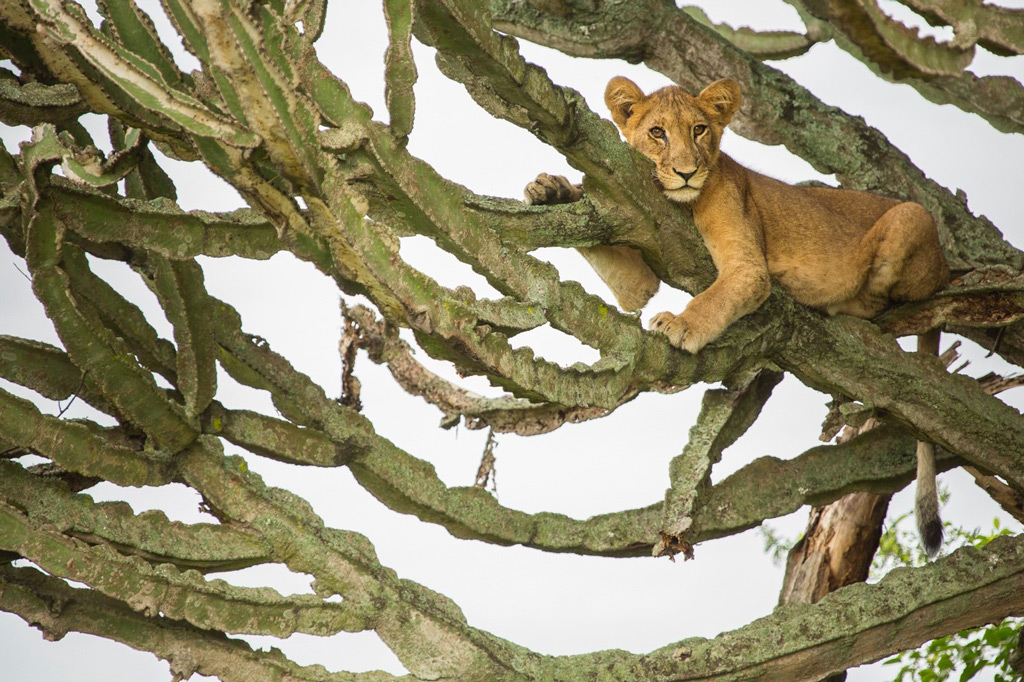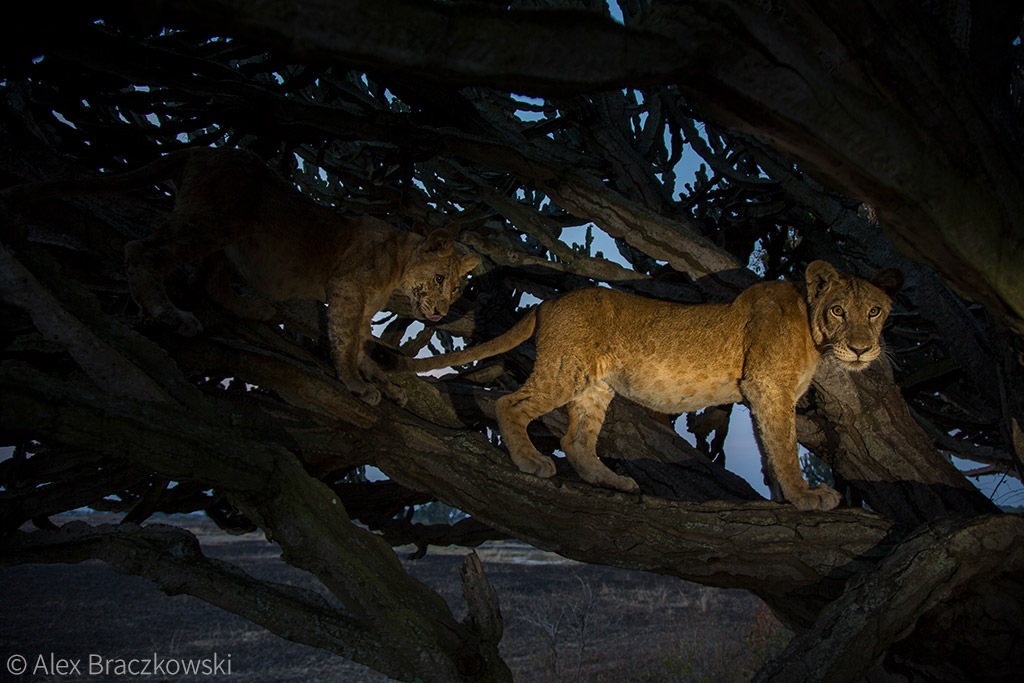By Alex Braczkowski, Mustafa Nsubuga, Arjun Gopalaswamy and Duan Biggs

It’s 35 degrees Celsius and the black dust from the recent bushfires stings our nostrils as we speed along a stretch of the Ishasha road in Uganda’s Queen Elizabeth National Park. We’re searching for a pride of lions that were spotted by tourists near the Congolese border just hours earlier. Sam Isoke, a longstanding field technician with the Wildlife Conservation Society suddenly slams on the breaks, before shouting, “`You see, in that fig tree over there?”. Yes, you read that last part right… as one of the rarest in all of Africa, this population of lions can be found regularly hanging from the branches of 40-foot-tall trees. In fact, the lions in this part of Africa spend about half of their lives in large sycamore fig trees and cactus-like euphorbias. We count four individuals, a large male affectionately known to local field rangers as Jacob, his two sisters Julia and Jessica, and their mother Jacqueline. This is the 89th day of such daily searching and our small team is exhausted from the relentless equatorial heat. We’ve been doing this because we are carrying out the first rigorous survey of lions in QENP, Uganda.

We started this research not only because there was uncertainty on how lion populations were faring in this part of the country, but also because there was broader evidence that the majority of historic surveys of African lions were missing the mark. The lack of good data on how many lions are left in Africa relates to a longstanding challenge in conservation, namely, to understand if management actions and conservation initiatives actually stop animal populations from declining (or even help them bounce back from human or natural pressures). This can be as simple as building a fence on the border of a national park to stop elephants stealing oranges, or paying farmers the market value of sheep eaten by bears, so they don’t retaliate and kill the bears. This is a dilemma faced by conservationists globally, across a wide strata of developing and affluent nations. If these interventions are applied without having a solid reference of how many animals a national park has to begin with, and how these change over time, the effectiveness of such interventions is questionable, maybe even futile. It may be argued that if conservationists and scientists spent more time in getting the numbers of threatened animal populations (including lions) right, we would be in a much stronger position to know how well our parks and conservation initiatives were doing, where to allocate resources and make sure the charismatic species the world enjoys didn’t silently go extinct.

The reality is that the three most seminal scientific studies (on fences, lion declines and a wide scale mapping exercise) published in the last ten years reporting on the number of lions in major African protected areas used questionable field methods like track counts, call up surveys or sometimes even direct observations in order to estimate lion numbers. A track or spoor count is literally what the name infers; a count of lion footprints that are related back to an estimate of true lion abundance (through a linear equation). A call up survey is a little better, and this entails blurting out the moans and groans of a dying buffalo or better yet, the whooping calls of a spotted hyena clan over a speaker system. These sound like a dinner bell for any lions in the area, which run towards the vehicle and can easily be counted by observers.

The problem with the direct application of call up surveys and track counts is that they make big assumptions about how lions (or their tracks) are detected in the landscape. These include how the footprints look on sand or mud, how they age, and eventually deteriorate, or even disappear in the baking hot sun or pelting rain. Just because you don’t see a lion footprint doesn’t necessarily mean a lion has not walked there. In fact, during our work in QENP, we followed a pride of lions and then looked at the substrate over which they walked. This soil was hard and not even one set of tracks was visible. With the call-ups you can’t even guarantee that the same lion isn’t being counted twice. The bigger problem yet is that these counts produce what scientists call wide confidence intervals which is a measure of precision. So, in theory a call up or track survey might estimate that there are 75 lions living in an area, but the lower estimate could be 15 lions, the upper 235. This wide uncertainty makes tracking how lions are faring nearly impossible in real time.


To attempt to solve some of these problems, we wanted to test a recently developed lion counting technique from a study in Kenya’s Maasai Mara on the rare tree-climbing lions of Uganda. This study used the so called “search-encounter” technique (which was originally applied on mountain lions) implying, as the name suggests, a procedure of driving a vehicle and looking for lions. By keeping a small GPS logger, which takes a location point every few seconds, a tracking log is created and this means that one can account for where search effort has been dedicated in the landscape, and the relative proportion of distance travelled in an area. Once lions are located, their GPS location is taken, as are high-quality photographs of their faces. Like housecats, lions have distinctive whisker patterns and other distinguishing features, which are akin to human fingerprints.

The location data, individual identity of lions and GPS tracking log are then entered into what scientists call a spatial capture-recapture matrix. This estimates the number of lions in an area statistically. With the advent of super computers and Bayesian statistical models we can get not only tighter estimates around the numbers of lions in a region, but examine how they move, and even ascertain their sex ratios, which are classical indicators of population health.


When we applied the search-encounter technique in Uganda we could draw on the information of how lions move in the landscape (based on their sex) and also examine their sex ratios. In our study we could actually compare how lions had changed their movements over a ten-year period. From 2006-2010 a team of Ugandan scientists, led by Mr Tutilo Mudumba radio collared nine adult lions in the south of Queen Elizabeth National Park (5 males and 4 females). They found that lion home ranges in this area were amongst the smallest recorded in East Africa (just 40 and 46 km2 for males and females respectively). Because our lion count featured information on where individual lions were located in the reserve, we could generate approximate minimum estimates of their range size in 2018 (a decade later). Our count of African lions showed that numbers in the park were quite low at only 2.7 lions/100 km2, totaling ~71 lions across the ~2500 km2 Queen Elizabeth Conservation Area. However, it was the movement patterns that were fascinating, with minimum home ranges expanding by some 400% for males and 100% for females respectively. The change in movement may be a reflection of depletion in the preferred prey that lions depend upon (topi, kob, waterbuck and buffalo) or human pressure on lions by snaring and retaliatory killings for livestock losses.

The unique situation in Queen Elizabeth National Park is that the tree-climbing behaviour of lions makes them easily detectable by rangers and tourists and thereby lions are frequently spotted. Had we not conducted our formal search-encounter survey of lions and performed a full-fledged statistical analysis from these data, we may have also not been able to detect the concerning trend of increased movement of lions.
The results of this lion survey have important ramifications not only for lions in this part of Uganda, but more broadly for other locations where lion numbers are shaky at best. Our review of historic lion surveys and numbers suggests there are large gaps in our knowledge of the status of the species. We argue that with the advances in mathematical models, supercomputing and easy to use field methods available to the lion conservation community we could fill these gaps rapidly. Indeed, the Kenya Wildlife Service and partners, took up an ambitious project of using the search-encounter approach combined with spatial capture-recapture analysis to survey the important source populations of lions and other large carnivores in Kenya. This project serves as proof that such reliable counting techniques can be scaled up to country-wide and region-wide scales.
With the current COVID-19 crisis and the collapse of the tourism sector, tracking how lion populations have fared when the world reopens will be essential in the continent-wide recovery effort for this much-loved icon of Africa.
We are grateful to the Uganda Wildlife Authority and WCS for their assistance in helping us use this method to determine the status of lions in western Uganda.![]()

Cited literature
Braczkowski, A., Gopalaswamy, A. M., Elliot, N. B., Possingham, H. P., Bezzina, A., Maron, M., … & Allan, J. R. (2020). Restoring Africa’s Lions: Start with good counts. Frontiers in Ecology and Evolution, 8, 138.
Braczkowski, A., Gopalaswamy, A. M., Nsubuga, M., Allan, J., Biggs, D., & Maron, M. (2020). Detecting early warnings of pressure on an African lion (Panthera leo) population in the Queen Elizabeth Conservation Area, Uganda. Ecological Solutions and Evidence, 1(1), e12015.
Elliot, N. B., & Gopalaswamy, A. M. (2017). Toward accurate and precise estimates of lion density. Conservation Biology, 31(4), 934-943.
Karanth, K. U., Nichols, J. D., Kumar, N. S., & Hines, J. E. (2006). Assessing tiger population dynamics using photographic capture–recapture sampling. Ecology, 87(11), 2925-2937.
Nichols, J. D., & Williams, B. K. (2006). Monitoring for conservation. Trends in ecology & evolution, 21(12), 668-673.
Russell, R. E., Royle, J. A., Desimone, R., Schwartz, M. K., Edwards, V. L., Pilgrim, K. P., & Mckelvey, K. S. (2012). Estimating abundance of mountain lions from unstructured spatial sampling. The Journal of Wildlife Management, 76(8), 1551-1561.
Karanth and Nichols (2017). Monitoring Methods for Tigers and ther Prey.
Duangchantrasiri et al. (2016). Dynamics of a low-density tiger population in Southeast Asia in the context of improved law enforcement. Conservation Biology.
Elliot et al. (2020). The importance for reliable monitoring methods for the management of small, isolated populations. Conservation Science and Practice 2020;e217.
National Lion and Predator Survey (2020). Africa’s first ever rigorous lion survey of key source populations. https://www.kenyawildlifetrust.org/portfolio-item/national-lion-predator-survey/
To comment on this story: Login (or sign up) to our app here - it's a troll-free safe place 🙂.![]()






